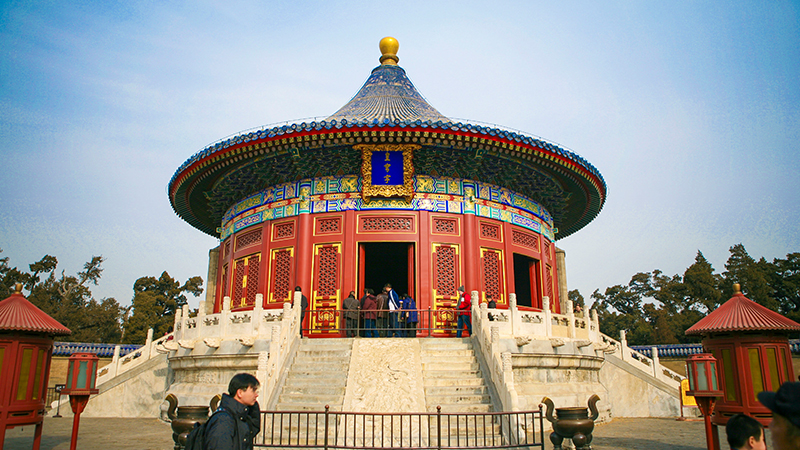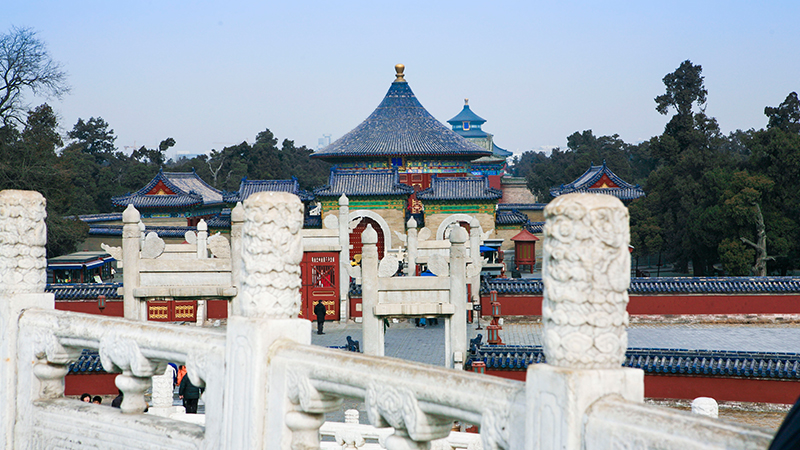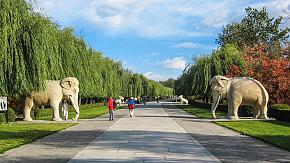Temple of Heaven: Beijing's Spiritual Heart
The Temple of Heaven is Beijing's spiritual epicenter and, along with the Forbidden City, one of the most important places in the city. Dating back to 1430 and the Ming Dynasty, the Beijing Temple of Heaven sits near the Forbidden City's Zhengyang Gate and was built to pray for a fruitful harvest through sacrifice and abstinence.
Visit the Temple of Heaven if you want to better understand Beijing's spiritual history, especially through the eyes of the Qing and Ming Dynasties.
The Temple of Heaven's Architecture and History
 Temple of Heaven
Temple of Heaven
The Temple of Heaven and the Forbidden City date back roughly the same time, with the Forbidden City being slightly older. Since they're in such proximity, it's a fine idea to visit both on the same day. The Beijing Temple of Heaven has very deliberate and meaningful architecture, with a square part representing Earth facing the south and a rounded half-circle representing Heaven facing the north.
In addition to the two physically distinct spaces representing the earthly and heavenly realms, the temple complex also has inner and outer areas, which accomplish different functions and have unique meanings. It's also vast, covering an entire 2.73 square kilometers, and it's good to have a solid game plan to see it all before you visit. You can enter this temple complex from one of four gates: North, East, South, and West.
Construction and Details
The temple was constructed when Yongle Zhu Di of the Ming Dynasty established Beijing as the capital of China. He took inspiration from a similar temple in Nanjing, the former capital. The Temple of Heaven underwent several changes over the years, with Emperor Zhu Houcong of the Ming Dynasty building the iconic Circular Mound Altar in 1530 and Emperor Qianlong reinventing the Hall of Daxiang into the Hall of Prayer for Good Harvest in 1791.
Visitors with a keen eye for details may notice that the temple complex's steps, platforms, and other features can all be divided by nine to pay homage to the nine distinct sections of heaven. These small details make the Temple of Heaven utterly unique. When you travel with us, we highlight what you should look for and help you make the most of your experience.
Important Structures of Temple of Heaven
 Inside the Hall of Prayer for Good Harvests
Inside the Hall of Prayer for Good Harvests
While the entire temple complex is impressive, several important structures and buildings stand out. The three primary buildings, the Hall of Prayer for Good Harvests, the Imperial Vault of Heaven, and the Circular Mound Altar, are arguably the most important elements of the temple. The Danbi Bridge, Baihua Garden and Rose Garden, and Divine Music Administration will also give visitors a deeper understanding and respect for the place.
Hall of Prayer for Good Harvests
 Admire the hall of prayer
Admire the hall of prayer
One of the key functions of the Temple of Heaven was to ask the God of Heaven for bountiful crops, and it's one of the most intricate and beautiful areas in the entire complex. Formed out of three circles, each one inside the other, and brightly painted wooden beams. It's a masterful representation of the artistry and style of the Qing Dynasty. The giant pillars are red and richly decorated with gold patterns, and the room has hints of gold, white, and deep blue throughout.
Imperial Vault of Heaven
 Imperial Vault of Heaven
Imperial Vault of Heaven
This slightly smaller structure is notable because there are no supporting beams to keep up the vast dome. Instead, the original craftsmanship of the building holds up the detailed, deep blue, vibrant red, and golden decorated dome.
Circular Mound Altar
 The gate of the Circular Mound Altar
The gate of the Circular Mound Altar
The Circular Mound Altar is another important structure made of three concentric rings, each a little higher up than the last. It's snowy white, decorated with carvings and designs, and is meant to represent heaven. In the center, you'll find the Heavenly Center Stone, a sacred place where it was common to pray for lucky harvests and good fortune.
The Fasting Palace
 The Fasting Palace
The Fasting Palace
The Emporer's red and blue Fasting Palace, or Palace of Abstinence, was a place for him to pray and deprive himself of distractions, alcohol, and food before praying to the Gods.
Danbi Bridge
 Danbi Bridge
Danbi Bridge
The Danbi Bridge is 360 meters long and spans between the Circular Mound Altar and the Hall of Prayer for Good Harvest. It is an excellent place to get wide-angle pictures of the exteriors of both these buildings.
Baihua Garden and Rose Garden
 Green scenery within the park
Green scenery within the park
While the buildings are undeniably one of the top draws of the Beijing Temple of Heaven complex, it's a good idea to spend some time on the grounds, too. The Baihua Garden and Rose Garden are gorgeous places where you can sit amongst the flowers and rest before or after exploring the complex.
Divine Music Administration
The Divine Music Administration was in the outer southern area of the Temple of Heaven, and these musicians and dancers were an important part of the temple's ritual and solemn nature. At any given time, there were between a few hundred and over a thousand people in this company during the Ming and Qing Dynasties.
There are several structures affiliated with the Divine Music Administration:
- Xianyou Hall
- Ningxi Hall
- 79 Verandas
Visiting the Temple of Heaven
 Wander in the site to admire all the halls
Wander in the site to admire all the halls
If you want to avoid the crowds, avoid visiting the Temple of Heaven during Chinese holidays like Golden Week, which runs between October 1 and October 7, or the Summer Holiday, which starts in July and lasts through August. Otherwise, this attraction is great to see any time of the year. It's also a good idea to visit in the morning when you can see local people doing exercises within the temple complex. It's a unique experience, and it will really help link the history of the temple with modern-day China.
The peak season is between the beginning of April and the end of October, and the temple complex opens at 6 a.m. and closes at 10 p.m. During the off-season, or between November to March, it opens at 6:30 a.m. and closes at 10 p.m. The last entry is at 9 p.m., regardless of the season. Some buildings, like the Hall of Prayer for Good Harvest, Circular Mound Altar, and Divine Music Administration, do not open until 8 a.m. during low and high seasons and close at 6 p.m. during peak season and 5 p.m. during off-season.
The Temple of Heaven is located at No. 7, Tiantan'neidongli, in Beijing's Dongcheng District. You can get there by metro. Take Line 5 to Tiantan Dongmen Station for the East Gate or Line 8 to Tianqiao Station for the West Gate. Multiple buses go near the East and West Gates, and the Temple of Heaven is easily accessible by taxi from anywhere in the city.
Travel Routes in the Temple of Heaven
Since the temple complex is fairly large, it's smart to follow a logical route that corresponds to the gate you enter by. Some people like to do it seasonally. For example, during the summer months, you can enter by the West Gate and start with the Baihua Garden and Rose Garden before heading to the Divine Music Administration and finishing at the Hall of Prayer for Good Harvests. During the autumn months, you can enter by the East Gate and start with the Halle of Prayer for Good Harvest, then continue over Danbi Bridge to the Imperial Vault of Heaven. We can help you map out a proper route that gives you the best and most authentic experience.
If you want your China trip to go as smoothly as possible, with personal care, in-depth travel itineraries that help you see the best of the country, and customer service that's always on hand to answer every question, Travel with China Odyssey Tours can help. Contact us today and get started with the vacation of your dreams.
What Our Clients Say
"Great Customized Service", "Trip of A Lifetime", "Exceed All Expectations"








